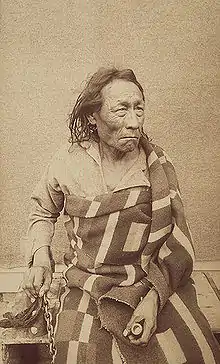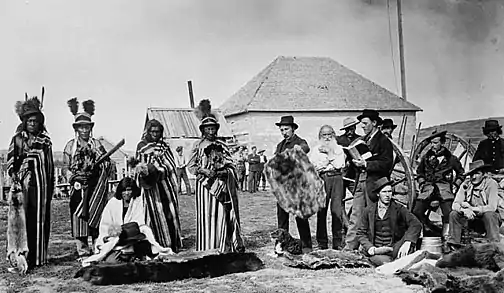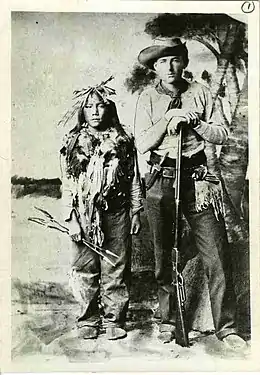Big Bear
Big Bear, also known as Mistahi-maskwa (ᒥᐢᑕᐦᐃᒪᐢᑿ; c.1825 – 17 January 1888[1]), was a powerful and popular Cree chief who played many pivotal roles in Canadian history. He was appointed to chief of his band at the age of 40 upon the death of his father, Black Powder, under his father's harmonious and inclusive rule which directly impacted his own leadership. Big Bear is most notable for his involvement in Treaty Six; he was one of the few chief leaders who objected to the signing of the treaty with the Canadian government. He felt that signing the treaty would ultimately have devastating effects on his nation as well as other Indigenous nations. This included losing the free nomadic lifestyle that his nation and others were accustomed to. Big Bear also took part in one of the last major battles between the Cree and the Blackfoot nations. He was one of the leaders to lead his people against the last, largest battle on the Canadian Plains.[2]
| Big Bear (Mistahi-maskwa) | |
|---|---|
| Cree headman | |
 Chief Mistahi-maskwa, 1885 | |
| Born | c. 1825 Jackfish, Saskatchewan |
| Died | 17 January 1888 Poundmaker Indian Reserve, Cut Knife, Saskatchewan, Canada |
| Father | Black Powder |
| Mother | Delaney |
Early life and leadership
Big Bear (Mistahi-maskwa, ᒥᐢᑕᐦᐃᒪᐢᑿ in syllabics) was born in 1825 in Jackfish Lake, near North Battleford, Saskatchewan. His father, Black Powder, was the chief of a tribe of 80 Plains Cree-Saulteaux people who were deemed to be "true nomadic hunters".[3] Little is known about Big Bear's mother. When Big Bear was old enough to walk on his own he spent his time wandering the camp socializing with many people, from the women to council members. In the spring of 1837, smallpox struck Big Bear's community and caused the quick departure of the Cree from the plains. Big Bear was infected with the virus but unlike many in the community, after two months of suffering he overcame it although it did leave his face partly disfigured.[4] After his recovery from smallpox, Big Bear began to spend a great deal of time with his father, including a journey by the two of them to Bull's Forehead Hill, where they spent a great deal of time reflecting and offering to their gods and spirits. Upon his reflection, Big Bear was visited by many spirits, but the bear took great prominence in his mind. After his reflection was complete he created a fur necklace in the shape of a bear paw with five ivory claws hanging from it, which he called the Chief's Son's Hand.[5] This necklace was the source of his nickname "Maskwa", meaning bear, and "Mistahi", meaning much, or big.[6]
It is reported that over the course of Big Bear's life he had several wives, producing at least four male children who would carry on his name, including his son Āyimis§s (Little Bad Man/Little Bear), who helped found the Montana First Nation reserve in Alberta and the Rocky Boy reservation in Montana.[7] There is little documentation to support the names of most of his sons.
Before becoming a great leader, Big Bear became a great warrior, taking warriors under his father's command on missions that he described as "haunting the Blackfoot".[8] Upon the death of his father Black Powder in the winter of 1864, his Band with over 100 members was in need of a chief. Big Bear was 40 years old and was the obvious choice. He would be the next chief.
Historical context
The Western Plains Indigenous People underwent a cultural, environmental and structural change starting in the mid-1870s and continuing into the late 1800s. Canada was attempting to cultivate the land that the Indigenous population occupied for European settlers. The treaties were the method of choice by the government to gain rights to the land; all Indigenous groups were given the opportunity, according to the government, to sign and receive the benefits of the treaty terms. However, the Indigenous People who did not want to sign were ultimately forced to sign because of environmental and cultural changes in 1870-1885.[9] The largest contributing factor to this was the disappearance of the bison which created a region-wide famine; in addition to this there was the emergence and widespread epidemic of tuberculosis which had a devastating effect on the Indigenous population.[10] The disappearance of the bison has been explained to some extent by the overhunting by white settlers to supply the fur trade which ultimately led to the famine. There were some attempts by the Canadian government to conserve the bison but the measures were not enacted in time to stop the drastic depletion of the bison food supply.[11] In the early 1880s tuberculosis was the main killer of the Indigenous people on the reserve, this disease was brought over by European settlers and spread through coughing and the sharing of pipes during tobacco-smoking ceremonies.[10] The disappearance of the bison was devastating to the Indigenous population because hunting allowed them to be self-sufficient and free from the dominion government; once the bison disappeared their need for assistance was imperative.[12] The Canadian government was the only option of survival but this meant signing the numbered treaties which would change their culture indefinitely. During this time Big Bear tried to withhold his signature from the treaty so that his people might get better terms but by 1885 malnutrition was severe and the meager rations given by the dominion government did not supply enough food. Big Bear was ultimately forced to sign the treaty to save his people from starvation and disease because the dominion government would not help unless they signed.[13] These factors contributed to the many deaths of Indigenous leaders leaving tribes without their history, which was taught by the elderly, and without men to lead their tribes changing their life from that point on.
Conflict with other Indigenous People



To be a Scrub Plains Cree Indigenous man it was an expectation to be an accomplished hunter and warrior, Big Bear was no exception to the rule. Big Bear was known to be a strong warrior and was often, as an adult, called upon to defend the community. A Cree man, to raise his position in the community, participated in raids and or attacks of enemy tribes which meant stealing of horses, land and food from their enemies. Big Bear's main responsibility was to be a hunter and provide for his family but he was involved in attacks against the enemies of the Cree.[15] The Battle of the Belly River was one of the largest battles the Cree were involved in. A constant enemy of the Cree was the Blackfoot tribe and in 1870 Big Bear was involved in an attack against the Blackfoot near present-day Lethbridge, Alberta. The Blackfoot band only lost 40 while the Cree lost between 200-300 warriors, it was known to be the largest Indian battle to be fought on the Canadian Plains.[2]
Treaty 6
As the 1870s began, Big Bear and his tribe had reached the high point of development for their Band. It started to become more and more apparent as time passed that these conditions would not remain the same forever. Disease had begun to ravage his people and the declining numbers of Buffalo threatened their food source and economy.[16] This was quite worrisome for Big Bear as both a father and a chief, and he knew something had to be done. On 14 August 1874, The Hudson's Bay Company visited Big Bear and his fellow Cree people. This was seen as peculiar to Big Bear and his people as the Hudson's Bay Company would have had to travel 7 days from the nearest trading post to visit their camp. The Hudson's Bay Company arrived with four wagons full of supplies.[17] Factor William McKay came along for the trip, (as he was an old friend with Big Bear) and while he was there he warned Big Bear of the establishment of the North-West Mounted Police in the area. McKay told Big Bear of how the North-West Mounted Police were here to preserve the west as Canadian and how they were not to interfere with but to protect aboriginal interests.[18] At the end of the visit, McKay and the HBC distributed gifts to the 65 tents of Big Bear's people; however, some were reluctant, they viewed the gifts and the North-West Mounted Police as a means of appeasement and incentive to start the treaty process with Canada.[19]
Big Bear began talks with the Canadian government in the 1870s in an attempt to work out a treaty. Big Bear was never open to the idea of reserve life, as he feared his loss of freedom and identity as a hunter.[20] But he knew as food sources grew weaker, and the best way for him and his band to avoid starvation was to sign a treaty with the Canadian government. By 1876, all major Plains Cree chiefs had signed Treaty 6 except for Big Bear. Big Bear stalled signing as he believed that the Canadian government would surely violate the treaty upon its signing. Big Bear said "we want none of the Queen's presents: When we set a fox trap we scatter pieces of meat all around but when the fox gets into the trap we knock him on the head. We want no baits. Let your chiefs come like men and talk to us."[21] Big Bear strongly believed that the Canadian government was simply telling him and his fellow chiefs what they wanted to hear. This led Big Bear to resist signing as well as pursue better terms for Treaty 6.
Big Bear made several attempts to warn the others against signing Treaty 6, at one point Big Bear rode by horseback to each lodge in the area urging people not to sign the treaty and not to give up the land, because it was so rich in natural resources.[22] Big Bear also resisted publicly at both Fort Carleton and Pitt, where the treaty was being signed. Big Bear understood the importance of making the best of this treaty as it would have implications on the generations to come. Big Bear also questioned the Eurocentric worldview and new order being brought forth with these treaties.[23]
There were also attempts made by others to discredit Big Bear in his attempt to pursue/change Treaty 6. John McDougall tried on several occasions to discount him. He claimed Big Bear was an outsider, that he was not of the area and did not deserve the esteem he carried among the people of this area.[24] This was not true as he was a Cree but also his father was Saulteaux (the other aboriginal group present in the signing of Treaty 6). He was not an outsider but rather leader of a group of people who had elements of both cultures.[25]
Big Bear resisted from signing from as long as he could but eventually had to sign Treaty 6 in 1882. He did so because he believed he had no other choice.[26] Big Bear believed he was betrayed by the other chiefs as they signed the treaty after all of his warnings. Big Bear's hope of negotiating a more favourable treaty for his people was over.
Life after Treaty 6 and the Trial of Big Bear
Big Bear had resisted signing Treaty 6 for four years. With food supplies running low and his people facing starvation, he was forced to sign the Treaty.[27] After signing the Treaty, Big Bear and his people could not decide where their reserve would be. Though they did not want to live on a reserve, in order to receive food rations from the government a location needed to be decided on. The first winter after signing the treaty, Big Bear and his people did not receive any rations as they had not decided what reserve to live on. It was in the year 1884 that Big Bear would meet Hudson's Bay Company clerk Henry Ross Halpin in Frog Lake, and the pair soon became friends. [28] In 1885 Big Bear had chosen a reserve to live on. After Big Bear was unable to choose a reserve quickly, he began losing influence over his people. Cree Chief Wandering Spirit rose in authority among the Cree people.[29] When the Métis initiated the North-West Rebellion of 1885 under Louis Riel and Gabriel Dumont, Big Bear and his supporters played a minimal role in the overall uprising, Big Bear's son Little Bear joined with Chief Wandering Spirit to go to Frog Lake and kill some of the white residents. Nine men were killed, and this later became known as the Frog Lake Massacre. Though Big Bear tried to stop this from happening, as he was a Chief he was arrested for treason. Big Bear had tried to solve the problems between his people and the Canadian government peacefully.[30] Many people felt Big Bear would be found 'not guilty' as he had tried to stop the Massacre at Frog Lake and tried to protect those that were taken prisoner. Henry Ross Halpin testified at his trial saying that he was just as much of a prisoner as he, himself had been. At the time of the trial, Big Bear was 60 years old. The trial was confusing for Big Bear as the trial was in English, and had to be translated into Cree. Hugh Dempsey has stated in his book, that Stanley Simpson, a man who was taken prisoner at Fort Pitt, was the only man to appear for the Prosecution. Much of the evidence was in favour of Big Bear innocence. The evidence was clear that Big Bear had not taken part in killings at Frog Lake or the looting and taking of prisoners at Fort Pitt. However, Big Bear was found guilty of treason and sentenced to three years at Stony Mountain Penitentiary in Manitoba. In 1887, after serving two years of his sentence, Big Bear was released due to failing health conditions. Big Bear died soon after being released on the Poundmaker Reserve in January 1888 at 62 years of age.
References
- Mistahimaskwa, Dictionary of Canadian Biography Online
- Wiebe, Rudy. "MISTAHIMASKWA (Big Bear)". Dictionary of Canadian Biography. University of Toronto.
- Wiebe, Rudy (September 16, 2008). Extraordinary Canadians Big Bear. Penguin Toronto. p. 7.
- Wiebe, Rudy (September 16, 2008). Extraordinary Canadians Big Bear. Penguin Toronto. pp. 10–11.
- Wiebe, Rudy (September 16, 2008). Extraordinary Canadians Big Bear. Penguin Toronto. p. 14.
- Wiebe, Rudy (September 16, 2008). Extraordinary Canadians Big Bear. Penguin Toronto. p. 15.
- Wiebe, Rudy. "MISTAHIMASKWA". Dictionary of Canadian Biography. University of Toronto. Retrieved April 1, 2015.
- Wiebe, Rudy (September 16, 2008). Extraordinary Canadians Big Bear. Penguin Toronto. p. 17.
- Friesen, Gerald (1987). The Canadian Prairies: A History. University of Toronto Press. pp. 148–149. ISBN 978-0-8020-6648-0.
- Daschuk, James (2013). Clearing the Plains: Disease, Politics of Starvation, and the Loss of Aboriginal Life. University of Regina Press. pp. 99–100. ISBN 978-0-88977-296-0.
- Friessen, Gerald (1987). The Canadian Prairies: A History. Toronto: University of Toronto Press. p. 150. ISBN 978-0-8020-6648-0.
- Daschuk, James (2013). Clearing the Plains: Disease, Politics of Starvation, and the Loss of Aboriginal Life. University of Regina Press. ISBN 978-0-88977-296-0.
- Daschuk, James (2013). Clearing the Plains: Disease, Politics of Starvation and the Loss of Aboriginal Life. University of Regina Press. pp. 160–161. ISBN 978-0-88977-2960.
- "Our Legacy".
- Jenish, D'arcy (1999). Indian Fall: The Last Great Days of the Plains Cree and the Blackfoot Confederacy. Toronto, Ontario: Penguin Group. p. 49. ISBN 978-0-670-88090-4.
- Miller, James Rodger (1996). Big Bear, Mistahimusqua. Toronto: ECW Press. p. 58.
- Miller, James Rodger (1996). Big Bear, Mistahimusqua. Toronto: ECW Press. p. 59.
- Miller, James Rodger (1996). Big Bear, Mistahimusqua. Toronto: ECW Press. p. 60.
- Miller, James Rpdger (1996). Big Bear, Mistahimusqua. Toronto: ECW Press. p. 60.
- Allard, Jean (2002). "Big Bear's treaty: The road to freedom". Inroads.
- McLeod, Neil (1999). "RETHINKING TREATY SIX IN THE SPIRIT OF MISTAH MASKWA (BIG BEAR)". The Canadian Journal of Native Studies.
- McLeod, Neal (1999). "RETHINKING TREATY SIX IN THE SPIRIT OF MISTAH MASKWA (BIG BEAR)". The Canadian Journal of Native Studies. XIX: 70.
- Mcleod, Neal (1999). "RETHINKING TREATY SIX IN THE SPIRIT OF MISTAH MASKWA (BIG BEAR)". The Canadian Journal of Native Studies. XIX: 71.
- Mcleod, Neal (1999). "RETHINKING TREATY SIX IN THE SPIRIT OF MISTAHI MASKWA (BIG BEAR)". The Canadian Journal of Native Studies. XIX: 75–76.
- Mcleod, Neal (1999). "RETHINKING TREATY SIX IN THE SPIRIT OF MISTAHI MASKWA (BIG BEAR)". The Canadian Journal of Native Studies. XIX: 76.
- Allard, Jean (2002). "Big Bear's Treaty: The road to freedom". Inroads. 11: 117.
- Dempsey, Hugh (2006). Big Bear: The End of Freedom. University of Regina Press. p. 120.
- Thompson, Christian (2004). Saskatchewan First Nations: Lives Past and Present. University of Regina. p. 28.
- Thompson, Christian (2004). Saskatchewan First Nations: Live Past and Present. University of Regina Press. p. 28.
- Dempsey, Hugh (2006). Big Bear: The End of Freedom. University of Regina Press. p. 122.
Further reading
- Hugh Dempsey, Big Bear : The End of Freedom, Vancouver: Douglas & McIntyre, 1984. ISBN 0-88894-506-X
- Blair Stonechild and Bill Waiser. Loyal Till Death: Indians and the North-West Rebellion (1997)
- Rudy Wiebe, The Temptations of Big Bear, Toronto: McClelland & Stewart, 1995. ISBN 0-7710-3454-7
- Jim Miller, Big Bear: (Mistahimusqua), Toronto: ECW, 1996. ISBN 1-55022-272-4
External links
- Mistahimaskwa (Big Bear)
- Biography at the Dictionary of Canadian Biography Online
- "Chief Big Bear". Cree Indian Leader. Find a Grave. Dec 7, 2003. Retrieved Aug 18, 2011.